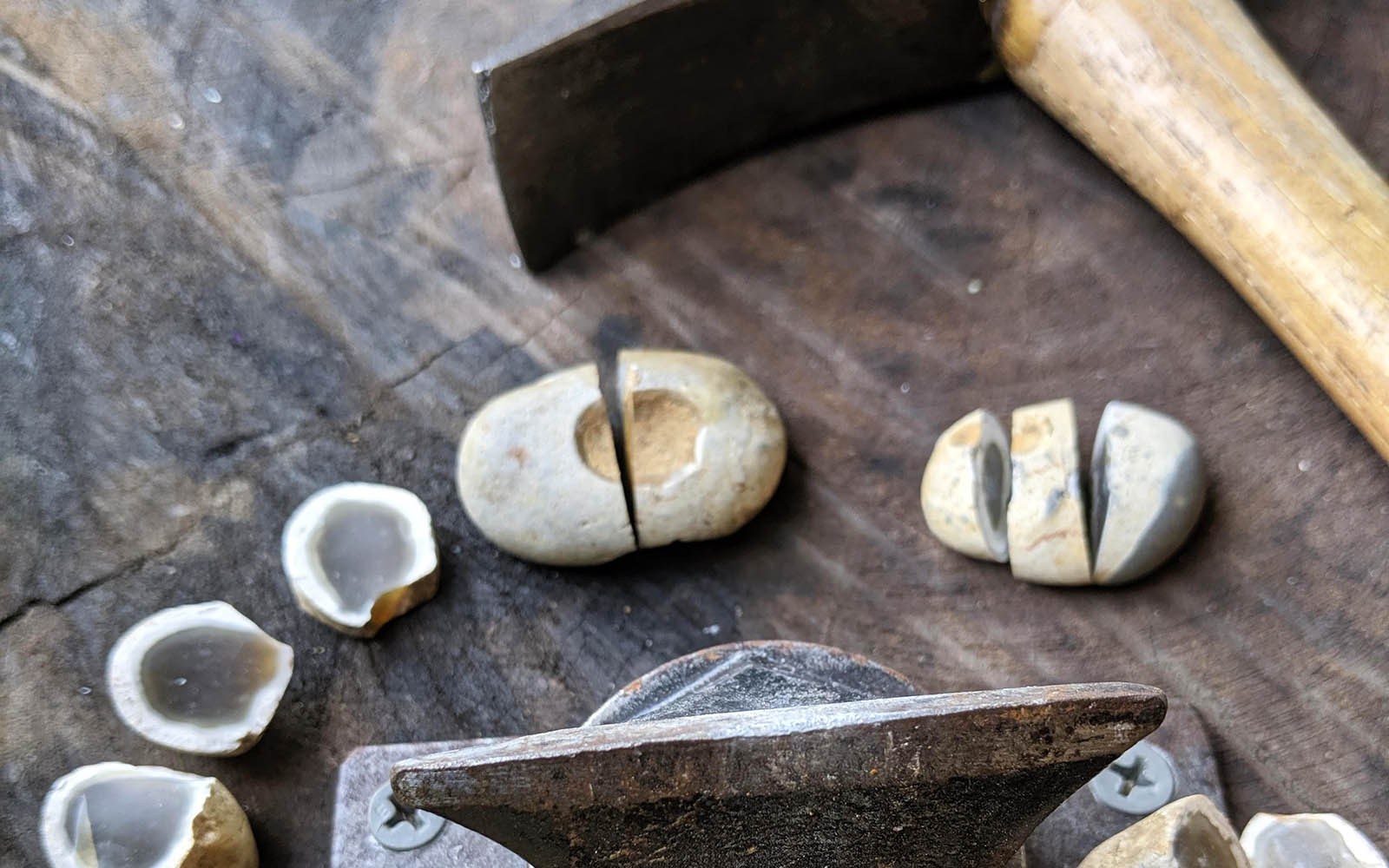
Rachel Sager’s The Ruins Project, Part Two
This week we are sharing the second of three articles by Rachel Sager reflecting on The Ruins Project, a long-term collaborative mosaic art installation amidst the ruins of a former coal mine in Fayette County, Pennsylvania. Rachel Sager operates the Sager Mosaics Studio, which is located near mile marker 104 on the Great Allegheny Passage and adjacent to The Ruins Project, which represents the rebirth of abandoned American coal country into a spiritual and artistic pilgrimage and destination for adventure seekers and lovers of art and history.
In her first article, Rachel introduced the site and the project and outlined her first rule for collaborators contributing artworks—they must Honor What Was. Rachel set in place a trio of rules the first year, before any of the collaborative art was begun. The rules apply to everyone. The artists use them to make mosaic in ways that preserve the delicate balance of her vision. The rules also help visitors to appreciate the story that is unfolding on deeper, more meaningful levels.
For today’s piece, she reflects on the second rule—to build relationships with the raw materials. The process reflects a sense of place—exploring creativity, storytelling, and mosaic traditions.
By Rachel Sager, Guest Contributor
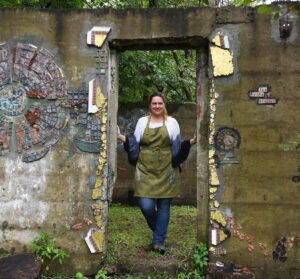
Rachel Sager
You can try talking to a stone, but most people will tell you it won’t talk back.
And if it does, you may have other problems that this hammer can’t solve.
I will give you a cheeky little smile as I explain that stones do talk.
For the right listener, stones have stories to tell.
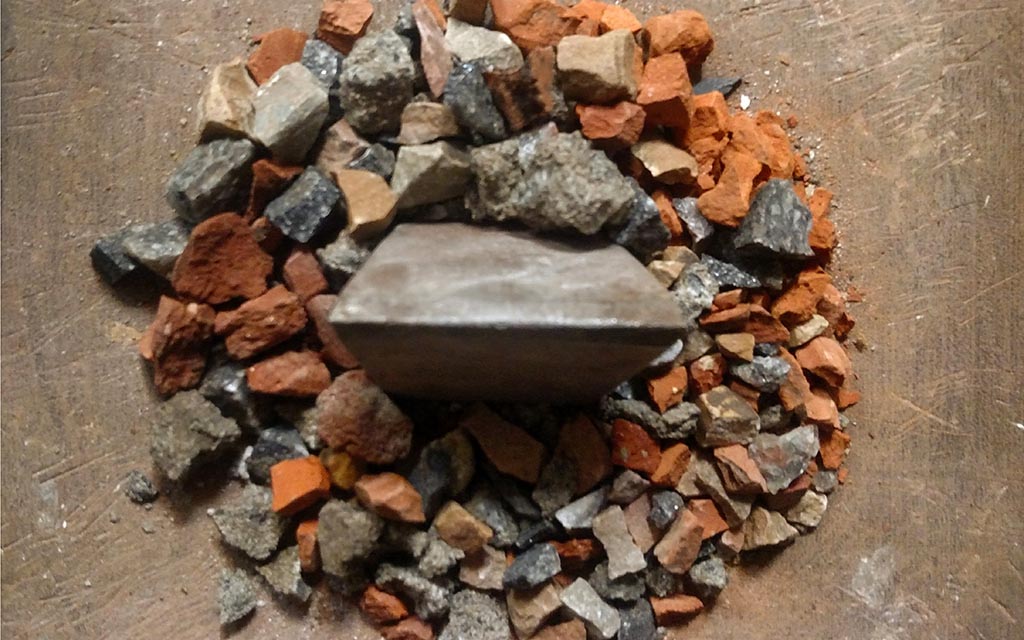
A girl can never have too many hammers. The traditional tools of the Roman mosaicists haven’t changed much in the last five hundred years.
The Search for a Stone
When happening upon the right stone, there is a fleeting moment when it seems that all things are possible.
Picture yourself walking along a riverbank. Head down, eyes focused. You have a goal.
Your goal is not simply to find something pretty (although you always leave room for that). Your goal is to find a stone that can be opened. You have been learning to cut things with your steel-tipped hammer and hardie (a chisel mounted upside down), and you want to begin the lifelong process of identifying what can be cut and what is better left alone.
You are not a geologist; you are a stone lover. You want to unearth the secrets. This walk along the river is your first date in what may become a long and passionate love affair.
You pick up lots of stones. You drop just as many.
You don’t realize it yet, but this first walk is about making the wrong choices.
You will fill up your bucket or bag or pockets with what you think are the right stones. You will lug them back to your workspace, wash them, scrub them, and lay them out in the sun. You’ll appreciate their angles and ridges.
You will think you know what they look like from these appreciating stages.
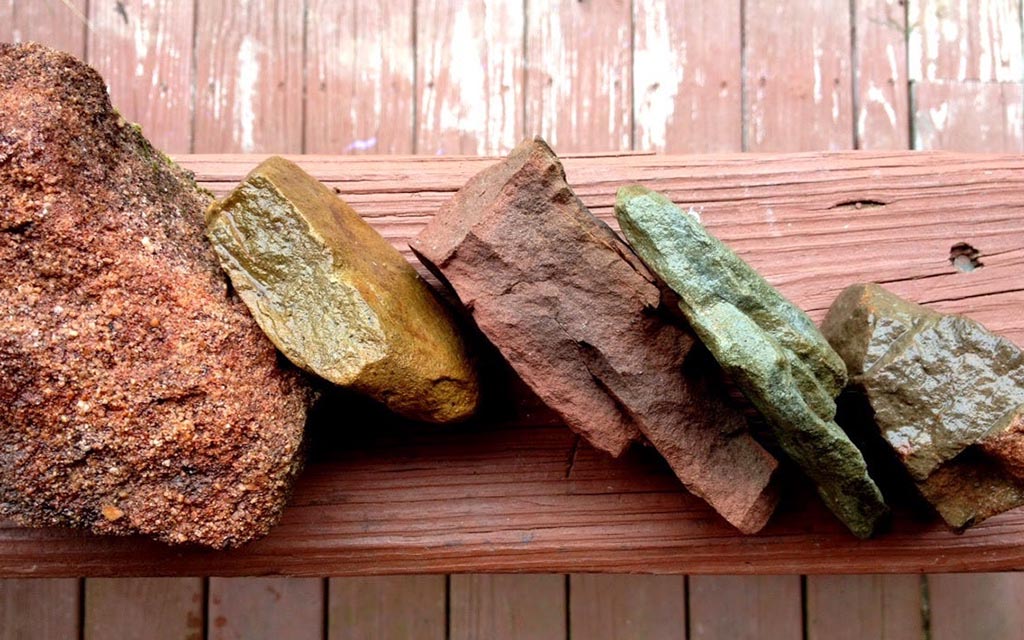
Stones from Touchstone Center for Crafts property. Photo by Kelley Knickerbocker.
But really, the best part is yet to come.
Cracking them open with your hammer is when their true nature is revealed because they have been rolling around in the air and the water and the forces of nature for so, so long that their outsides have changed. It’s like looking at a walnut: the green outer shell gives you clues as to what the dark, ridged inside reveals, but the clues take time to learn, and they can be tricky.
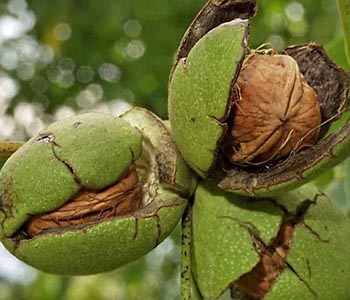
The Black Walnut
The inside of a rock is almost always a different color and texture from the outside. It’s a present from the past, waiting for you and your hammer to reveal its nature. Will it be sandy or smooth? Reddish or grayish? Will it cleave like butter or withstand your hammer strikes like a rocky vault?
With time put in, you will realize that the speckled, egg-shaped calling card of granite is not worth the trouble. It’s too hard on your hands and your hammer. You will learn that sandstone is a beginner’s joy and limestone is just difficult enough to cut that you may need help from a seasoned mosaicist to learn the tricks for working with it.
With enough time put in, you may come to give certain stones nicknames and personalities. I call sandstone humble and limestone sophisticated.
And then there is red dog. This stone deserves a category all its own.
 Red Dog: The Storytelling Stone
Red Dog: The Storytelling Stone
We are always on the hunt for “choice” red dog, the kind that has black embedded into the insides and rosy reds on the outsides.
The imagining is one of my favorite parts. You let your imagination sweep you back up the river, where a stone has traveled to get here. Was it washed all the way from West Virginia? Did it break off from a giant monolith of sandstone to be washed here, today, for you to discover it?
Or was it once something else entirely? Red dog is the colloquial term for a byproduct of the bituminous coal industry during the decades that Banning #2 coal mine, now The Ruins Project, was in operation.
A coal miner during these times was paid by the ton, not the hour. If he couldn’t get his ton of coal out of the hillside and onto a car to be weighed, he very likely couldn’t feed his family. This working by material weight created an urgency throughout the entire process of coal extraction. From the diggers with shovels to the bosses wearing suits, it was all about the volume.
In their urgency, the men dumped anything that wasn’t coal along the riverbanks. Decades of dumping created small mountains of the black shale that was tucked up tightly against the seams of coal.
A miner was only paid for the coal, but he had to move the shale too.
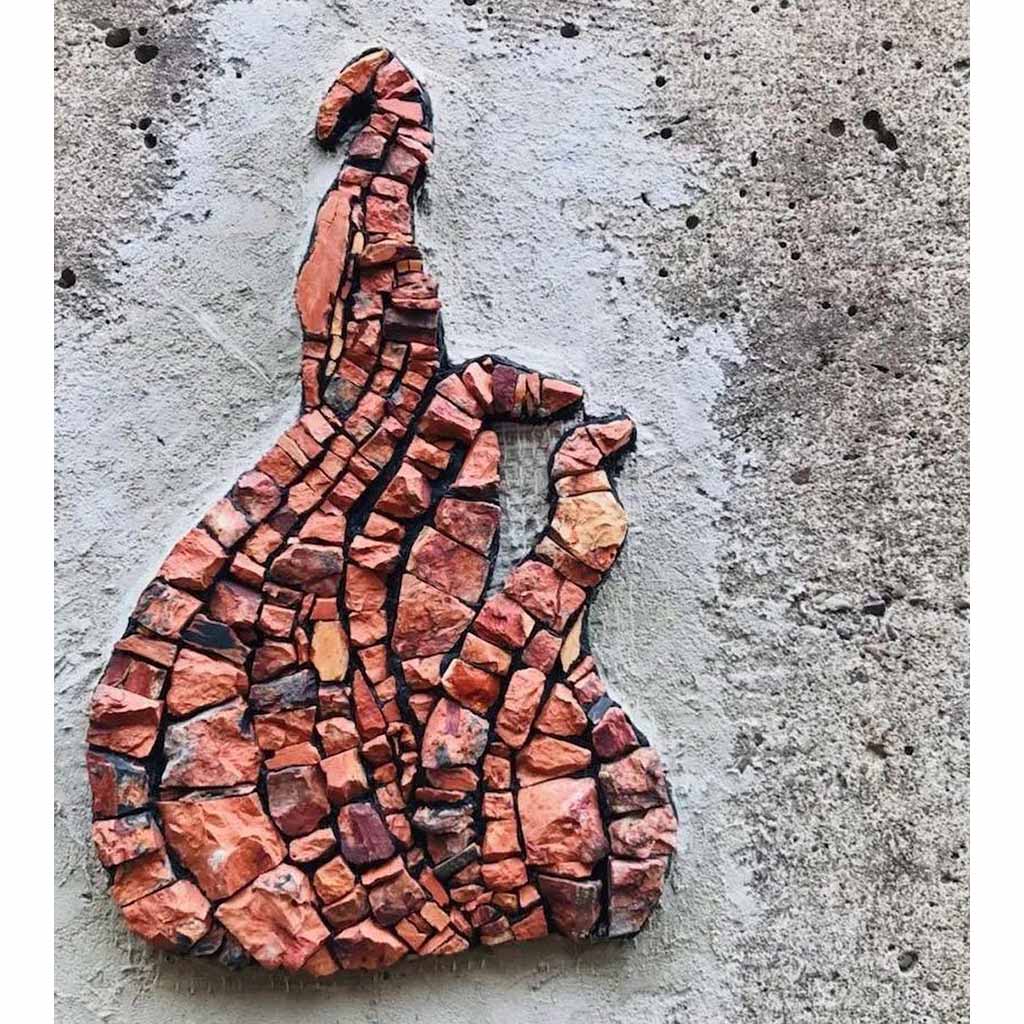
A red dog flame to symbolize the fire that created it. By Ruins artist Julie Christmann.
These hills of refuse would catch fire periodically and burn deep inside—the kind of hot burning with no air that transformed the black Youghiogheny shale into incredible shades of red. All the colors of red from the Crayola box: burnt sienna, brick, copper, bittersweet, apricot, salmon, and even violet red.
The shale on the inside, the burnt-by-fire on the outside. Red dog is part geologic, part manmade. For The Ruins artists, it represents an opportunity to work with a beautiful, unique mosaic material that has history wrapped into its mysterious layers.
Building relationships at The Ruins is a bottomless bank of possibilities. We don’t go shopping at stores for our mosaic tesserae (the small pieces used in mosaic). We are more likely to find raw stone and transform it with our hammers in surprising ways.
Each artist has the freedom to translate their relationship to mosaic material in unique ways. Some use glass. Others ceramic. And many choose stone.
I will highlight two Ruins artists to explain.
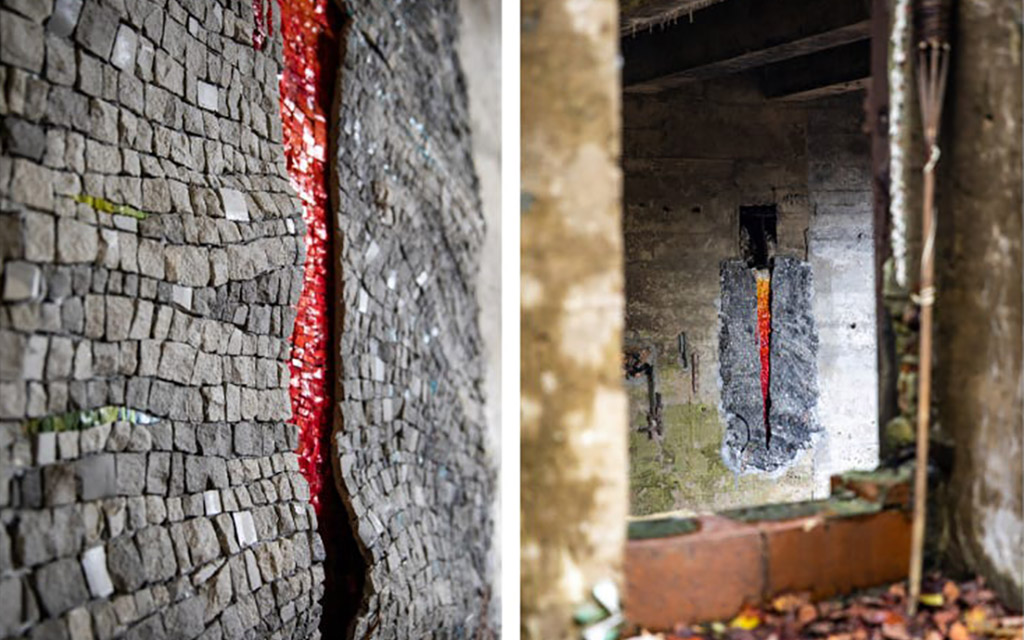
East Meets West. Photos by Bri Santoro.
Anabella Wewer’s East Meets West
Classically trained mosaicist Anabella Wewer took her relationship building to astonishing lengths with the masterful East Meets West composition, built to represent the heat of the steel industry. Standing below it, looking up, one feels the connection between coal and steel.
It’s a perfect symbol to connect Rivers of Steel and The Ruins Project. The bituminous coal from Banning #2 was loaded onto The P and LE coal cars that would then make the many journeys north to fuel the Carrie Furnaces.
But looking at it and understanding it are two different things.
The artist wanted gray material. She needed a lot of it given the large size of her planned five-foot by three-foot composition. She also wanted to achieve a strata effect that felt like the depths of the earth. Anabella says, “pouring my own concrete made sense once I decided to make the molten steel look as if it was breaking through the concrete wall.”
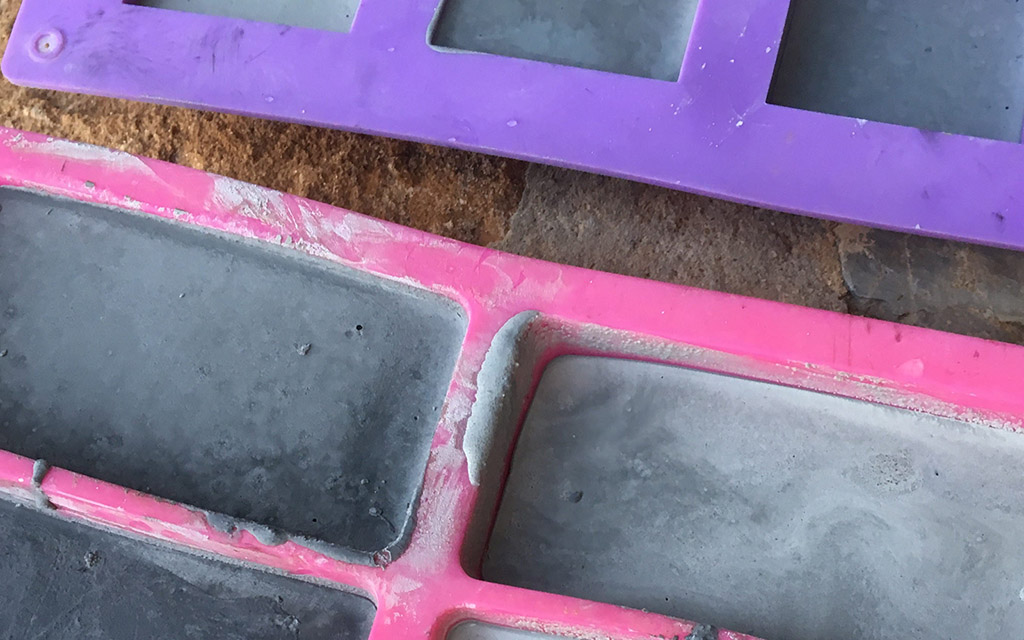
The artist tinted and poured her own shades of concrete. In all, seven shades of custom-created tesserae help to make up the nuanced color changes in East Meets West.
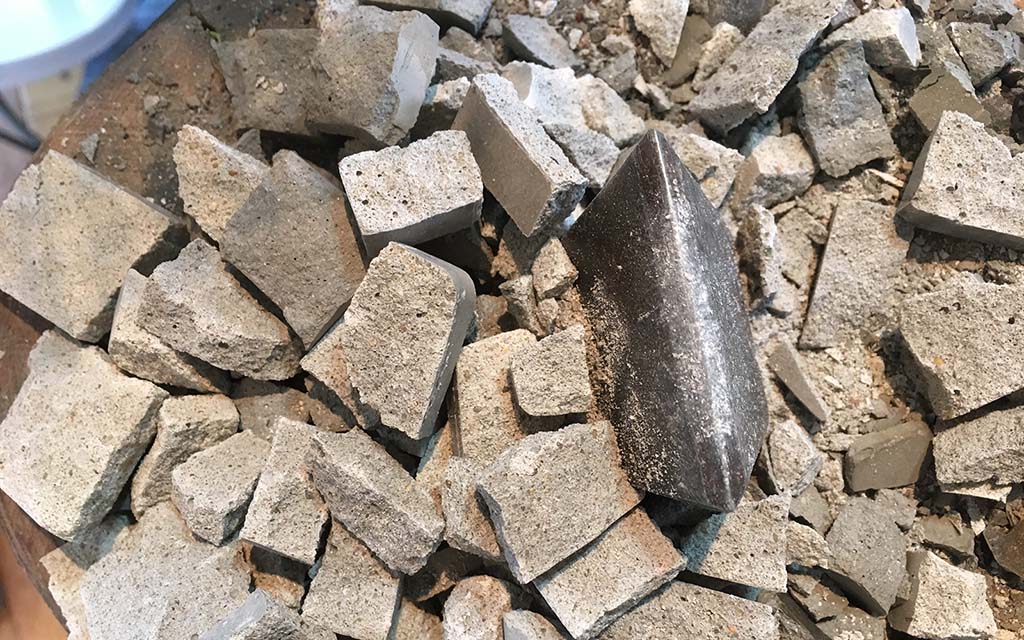
The finished raw material.
It’s one thing to cut every piece of tesserae with a hammer, an already time-consuming process. It’s quite another to pour molds for your own handmade raw material and then cut them down into the small squares that are the building blocks for classical mosaic.
The results look like natural stone but are actually hand-poured and then carefully cut concrete.
Anabella lovingly added this extra step of work to the process—such a quintessentially Ruins things to do.
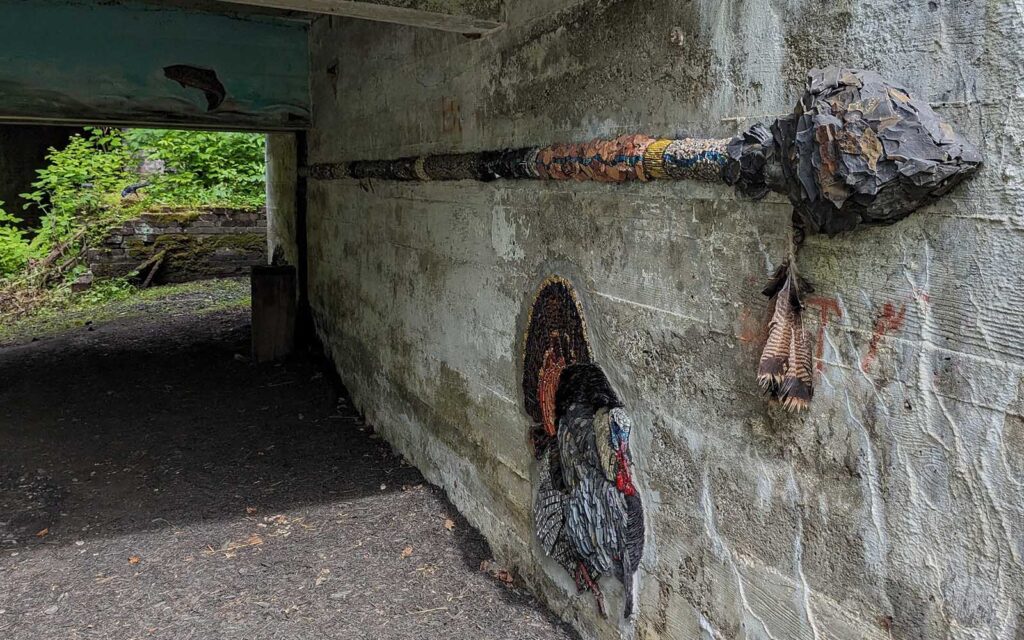
The Arrow is the anchor for the many animals that make up The Cave.
Wendy Casperson’s The Ruins Arrow
Wendy Casperson is a self-taught McKeesport artist has been slowly but tenaciously building a twenty-six-foot-long mosaic arrow in a room loosely titled The Cave. It’s a space dotted with native animals and represents a time before the people of coal. The Ruins Arrow is a symbol of the many indigenous tribes that once thrived along this river valley. The arrow is built from dozens of materials ranging from Marcellus shale, coal from The Ruins, river pebbles, stained glass, freshwater clam shells, iron ore pellets, red dog, sandstone, and possibly the most surprising of tesserae, deer teeth.
Wendy has become a mosaicist through building the many sections of The Arrow. She has adopted a phrase that personalizes the idea behind building relationships here at The Ruins. It has become a kind of identity for an artist carving a path into mosaic.
I am the Arrow.
Wendy takes great care in choosing each new section and learns how to cut and shape its materials as she works in situ on the wall. She forages the Youghiogheny River, both the banks and the river itself, and often collects animal skulls and bones to incorporate in the andamento (the flow of lines in a mosaic piece) of The Arrow. As a local artist, she has the luxury of taking her time as she builds relationships with each new chosen material.

The meandering blue line of smalti (colored glass or enamel) to represent the river is the one constant material throughout the composition.
The Ruins is Relationships
There are over 250 Ruins artists who take the time and effort to build relationships with raw material as they build their mosaic art for the giant cement canvas in the woods.
It is not lost on me that as the artists build relationships with stone and glass, they are also cementing friendships and professional bonds with me and with each other.
Each stone cut and laid into mortar is one more connection in a long line of andamento that makes The Ruins a one-of-a-kind creative force that is changing how the world understands the art of mosaic.
All images are courtesy of Rachel Sager.
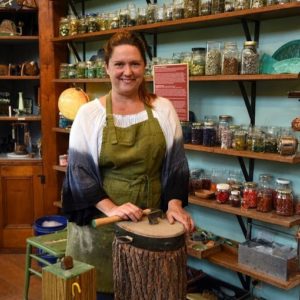 Rachel Sager, The Storytelling Mosaicist, has been making mosaic, writing about mosaic, speaking about mosaic, and teaching mosaic for over twenty years. Her signature forager and intuitive teaching styles have changed how mosaic is experienced and have helped build on the golden age that the art form is enjoying in these exciting decades.
Rachel Sager, The Storytelling Mosaicist, has been making mosaic, writing about mosaic, speaking about mosaic, and teaching mosaic for over twenty years. Her signature forager and intuitive teaching styles have changed how mosaic is experienced and have helped build on the golden age that the art form is enjoying in these exciting decades.
As the owner and creator of The Ruins Project and Sager Mosaics, Rachel lives and works as an Appalachian entrepreneur in the hills and hollows of her hometown just down the river from Pittsburgh in Fayette County.
The easiest (and most engaging) way to keep up with what’s happening at The Ruins is by subscribing to The Ruins Substack which is also where you can find the growing episodes of The Ruins Podcast, a collection of conversations that Rachel hosts with all walks of creative people who interact with her cathedral to coal.
She hopes you will join her in her quest to unearth optimism; some days with a shovel, some days with a hammer, and some days with a pen.
The Ruins is accessible through guided tours only. To make arrangements go to Book a Tour.
This is the second in a series by Rachel Sager. You can read Honor What Was, the first rule, and stay tuned for Rule #3 with more of The Ruins story.

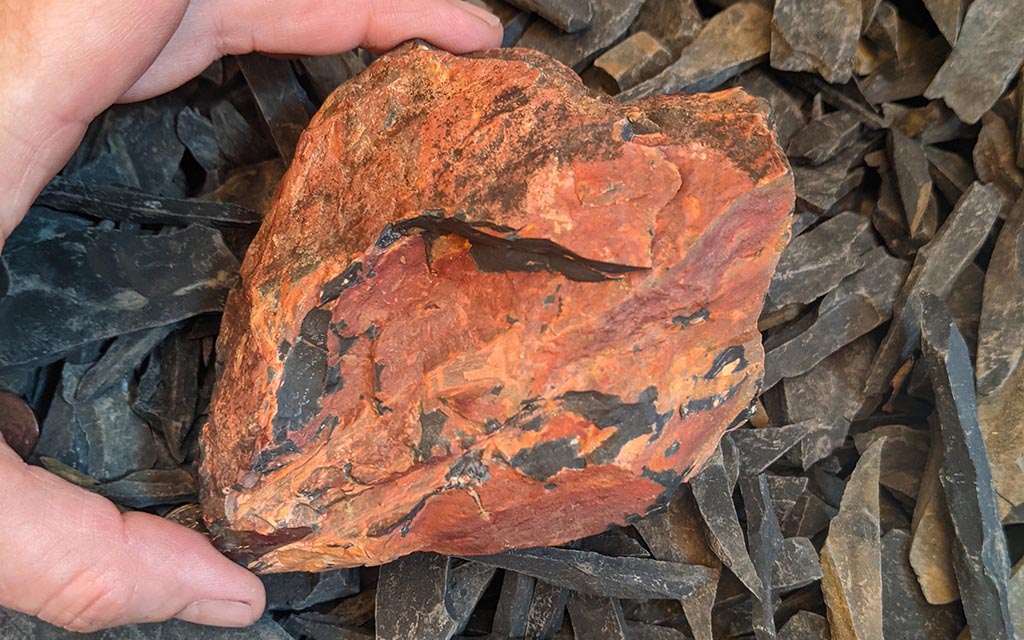 Red Dog: The Storytelling Stone
Red Dog: The Storytelling Stone





